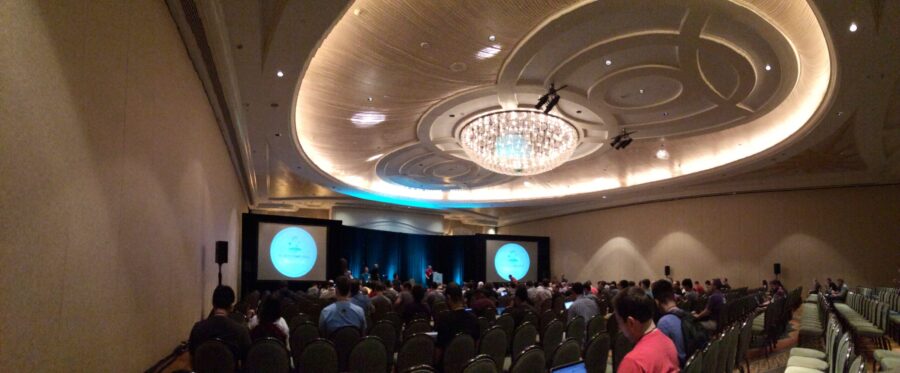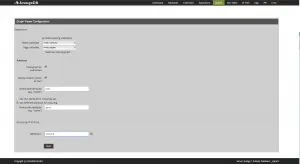ArangoDB Xmas Edition 1.4.4: Release Notes and Updates
This version is deprecated. Download the new version of ArangoDB
We have released the bug-fix version 1.4.4 of ArangoDB. While this version only contains minor fixes, we have switched to a new build system for Windows. We are now using Visual Studio 2013 and CMAKE to build ArangoDB under Windows. This also includes a new installer (Nullsoft Scriptable Install System). ArangoDB can now be installed as a service under Windows.
Unix The configuration is now called “arangod.conf” instead of “arangod-uid.conf” in order to avoid confusion.
Windows The default installation directory is “c:Program FilesArangoDB-1.x.y”. During the installation process you may change this. In the following description we will assume that ArangoDB has been installed in the location ROOTDIR. You have to be careful when choosing an installation directory. You need either write permission to this directoy or you need to modify the config file for the server process. In the latter case the database directory and the Foxx directory should must be writable by the user.
Installating for a single user Select a different directory during installation. For example “C:/Users//arangodb” or “C:/ArangoDB”. Installating for multiple users Keep the default directory. After the installation edit the file “ROOTDIR/etc/arangodb/arangod.conf”. Adjust the “directory” and “app-path” so that these paths point into your home directory.
[database] directory = @HOMEDRIVE@/@HOMEPATH@/arangodb/databases [javascript] app-path = @HOMEDRIVE@/@HOMEPATH@/arangodb/appsCreate the directories for each user that wants to use ArangoDB.
Installating as Service Keep the default directory. After the installation open a command line as administrator (search for “cmd” and right click “run as administrator”)
cmd> arangod –install-service INFO: adding service ‘ArangoDB – the multi-purpose database’ (internal ‘ArangoDB’) INFO: added service with command line ‘”C:Program Files (x86)ArangoDB 1.4.4binarangod.exe” –start-service’Open the service manager and start ArangoDB. In order to enable logging edit the file “/etc/arangodb/arangod.conf” and uncomment the file option.
[log] file = @ROOTDIR@/var/log/arangodb/arangod.logArangoDB at RubyConf 2013: Insights and Presentations
RubyConf is a yearly conference in the USA with people coming from all over the world to discuss about Ruby, Rails and related topics. Every year a different city hosts this conference – this year the conference took place in sunny Miami Beach. This year Dirk Breuer – the other main developer behind Guacamole – and I went there to learn from the speakers talking about a wide range of topics. Apart from the great talks there was a lot of opportunity to talk to Rubyists from entirely different areas like social networks or banking backend systems, the problems they face and the solutions they found for them. Of course there were a lot of people catching a sight of our ArangoDB shirts and coming towards us to ask about ArangoDB and the Ruby support. The question ranged from basic questions (“What is ArangoDB?”) to more involved questions about AQL for example. As always we were happy to answer all of them!

Main hall of RubyConf 2013
All videos from the conference are online now. The excellent keynote by Katie on the second day is not only interesting to Rubyists, but everyone enthusiastic about programming and especially teaching it. If you understand German and want to get more tips about which talks to watch, download episode 26 of Geekstammtisch where we discussed RubyConf.
ArangoDB Goes to Barcelona | NoSQL Matters 2013 Event
The ArangoDB team traveled to Barcelona for the “NoSQL matters” – weekend. Day one was packed with a lot of NoSQL-trainings and Jan introduced the NoSQL landscape by explaining how to model your data in a non-relational world. Following the wish of many participants Jan had to repeat the morning session about the new and exciting possibilities of NoSQL in the afternoon.
After an inspiring key-note by Nathan Marz, three tracks full of NoSQL, BigData and Searching explained the latest trends.
Lucas talked about ArangoDB in general, Foxx and the advantages of multi-models. He explained “why relations — especially properties graphs — matter even in a NoSQL database” by Sarahs Mei’s example of social networks.
After his talk, we had a lot of interesting and inspiring discussions at the ArangoDB booth in the entry hall.
NoSQL matters was a great experience for us, which gave the ArangoDB team the opportunity to meet a lot of interesting people to exchange and to develop new ideas.
Graph Visualization Techniques | ArangoDB: Insights & Tutorials
Using ArangoDB as your graph database?
you now have the opportunity to visualize your data graphically, using the “Graphs” tab in the admin interface.
In this post i will explain you how to do this:
Step 1) Configure the Interface
At first you have to configure the interface to display exactly the data you desire.
For the dataset you have two options:
- Select one vertex and one edge collection directly
- Select the graph by name created using the graphs api
- Manage your graphs
Then the interface offers you several advanced options:
- Decide if the graph is directed (only outbound edges are followed) or undirected (all edges are followed). By default we treat your graphs as undirected
- Define if you want to start at a random vertex in the graph. By default we will do that.
- Then you can define which of your attributes should be used as the label on the verticies. By default we will use the _key for this.
- Now lets bring in some colour. You can either use the same attribute for colouring as for labeling, but you can also use a different one
- Finally you can define a grouping of new nodes. This is useful to speed up the performance of the interface and to increase the usability. You can define a priority list of attributes here, which is elaborated from top to bottom: All vertices having the first attribute defined are grouped by its value. All other nodes are grouped by the second attribute if present etc.

Graph Visualization Screencast | ArangoDB: Advanced Techniques
In the latest version of ArangoDB (1.4) we have introduced a new tab in the Admin Interface: Graphs.
You can use this tab to view and modify your graphs stored in ArangoDB.
In this screencast you will get a short introduction on how to use the new system.
Elasticsearch Plugin: ArangoDB Integration | ArangoDB ’13
ArangoDB River Plugin for ElasticSearch
ArangoDB offers now a plugin for automated data transfer from ArangoDB into ElasticSearch.
If you want to benefit from ElasticSearch’s full text search capabilities for your ArangoDB document data, the easiest way to do so is to use this new plugin.
Implementing the push approach, otherwise, would make it necessary to write your own indexer, using your favorite programming language.
The ArangoDB river plugin software is an initial alpha version and licensed under the Apache 2 license.
(more…)
ArangoDB 1.4: Replication Feature Overview | ArangoDB ’13
ArangoDB 1.4
comes with asynchronous master-slave replication. The new replication feature should make it much easier to create a backup from a running ArangoDB server. For example, a second ArangoDB instance can now be used as a slave by cloning all data from the master. The slave will be populated in the background while the master is running and accepting requests – not disrupting the master operations.
ArangoDB 1.4.0 Released: Discover New Features | ArangoDB ’13
This version is deprecated. Download the new version of ArangoDB
We are proud to announce that version 1.4.0 of ArangoDB has been released. The release is available for download here: https://www.arangodb.com/download Thanks to all contributors and testers for your enormous help!
Features This release is a major milestone for us, because it contains two of the most wanted features:
- replication
- multi-database support It also comes with:
- Foxx, a lightweight framework for building APIs and applications, see https://www.arangodb.com/manuals/current/UserManualFoxx.html
- a new and much improved admin web interface, including an intuitive graph browser, see http://www.arangodb.com/manuals/current/NewFeatures14.html#NewFeatures14WebInterface
- full swagger API documentation, allowing you to easily test and play with the server API using a browser
- an easy to use import/export tool, see http://www.arangodb.com/manuals/current/NewFeatures14.html#NewFeatures14DumpReload
- an asynchronous request API (can be used for “fire-and-forget” requests and decrease client waiting time)
- and several other improvments The complete list of new features can be found here:
http://www.arangodb.com/manuals/current/NewFeatures14.html (more…)
ArangoDB on Raspberry Pi: Database Power for Small Devices
During the ArangoDB Hackathon weekend, we tried to compile ArangoDB on a Raspberry PI using Raspbian as operating system.
ArangoDB needs some external libraries in order to compile
- libev
- ICU
- V8
- zlib
Libev, ICU and zlib compiled without problems. Raspbian comes with a precompiled version of V8 – but it’s too old for ArangoDB. So, we had to compile V8 ourself. A single make run takes hours and hours to complete. Using the default parameters it complains about wrong flags for the hard-float ABI. After some googling and endless hours of waiting for the compile to complete, we found a set of flags that finally worked.
- you need to pass the options -march=armv6 to the compiler and linker
- you need to disable CAN_USE_VFP3_INSTRUCTIONS
- use -O2 instead of -O3 (I’m not sure if this is necessary or not)
If you downloaded ArangoDB 1.3, use the following diff to patch the Google V8 Makesystem
ArangoDB on Raspberry Pi: Explore Possibilities | ArangoDB ’13
During the ArangoDB Hackathon weekend, we tried to compile ArangoDB on a Raspberry PI using Raspbian as operating system.
ArangoDB needs some external libraries in order to compile
- libev
- ICU
- V8
- zlib
Libev, ICU and zlib compiled without problems. Raspbian comes with a precompiled version of V8 – but it’s too old for ArangoDB. So, we had to compile V8 ourself. A single make run takes hours and hours to complete. Using the default parameters it complains about wrong flags for the hard-float ABI. After some googling and endless hours of waiting for the compile to complete, we found a set of flags that finally worked.
- you need to pass the options -march=armv6 to the compiler and linker
- you need to disable CAN_USE_VFP3_INSTRUCTIONS
- use -O2 instead of -O3 (I’m not sure if this is necessary or not)
Get the latest tutorials,
blog posts and news:
Thanks for subscribing! Please check your email for further instructions.
 Skip to content
Skip to content 
